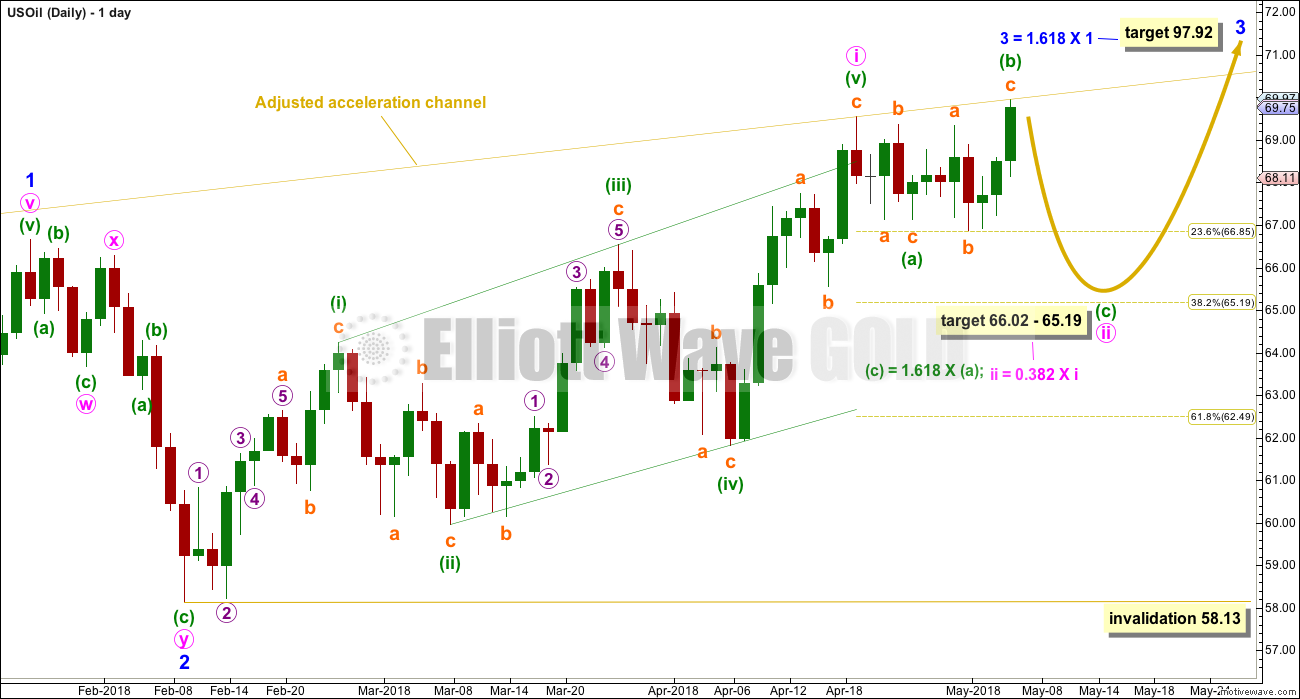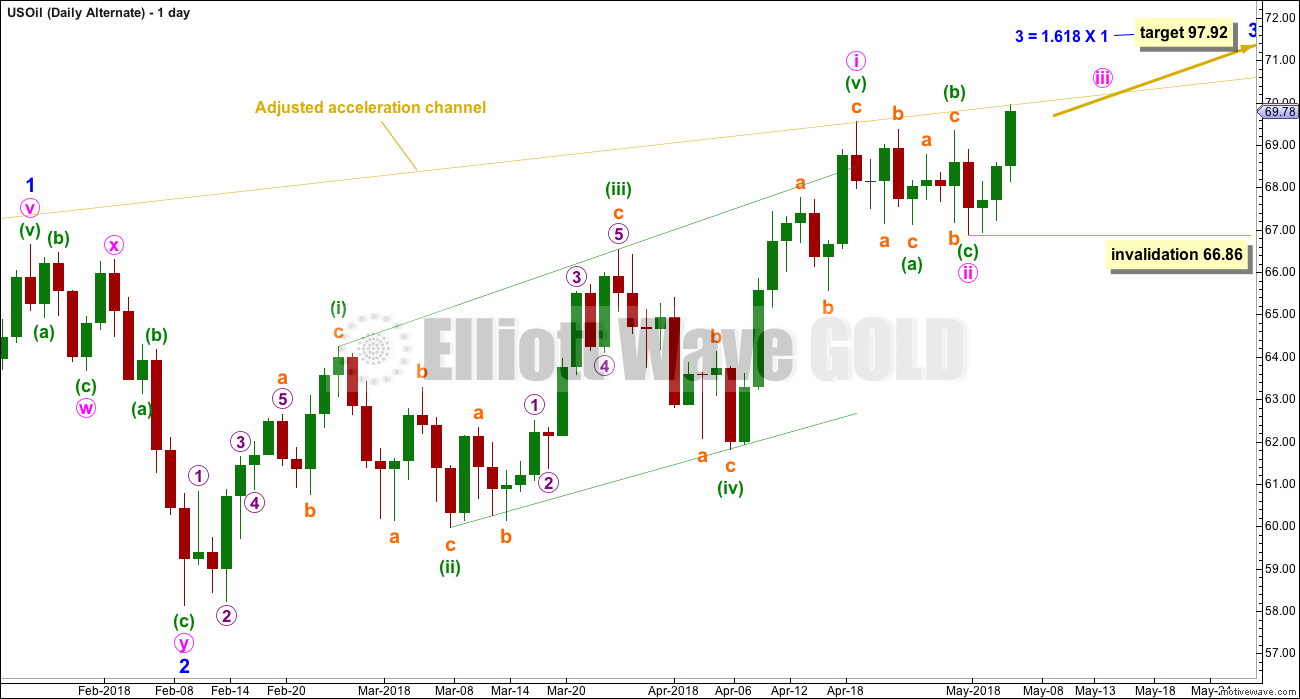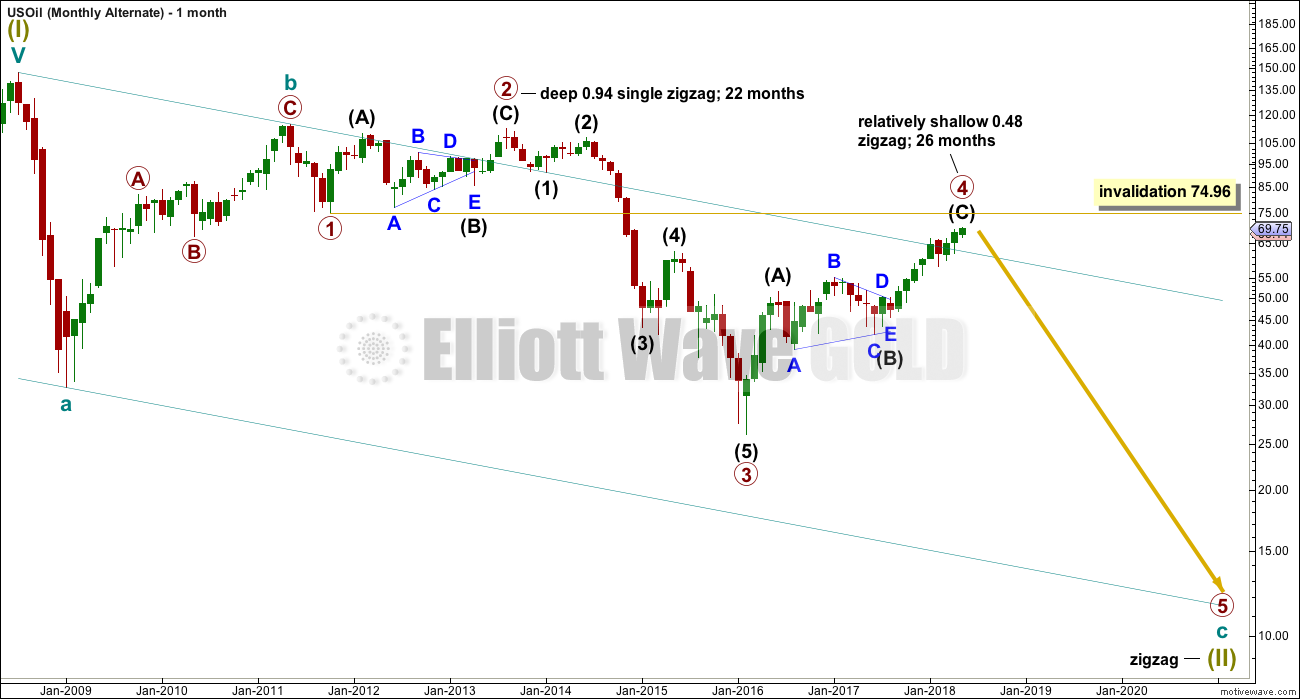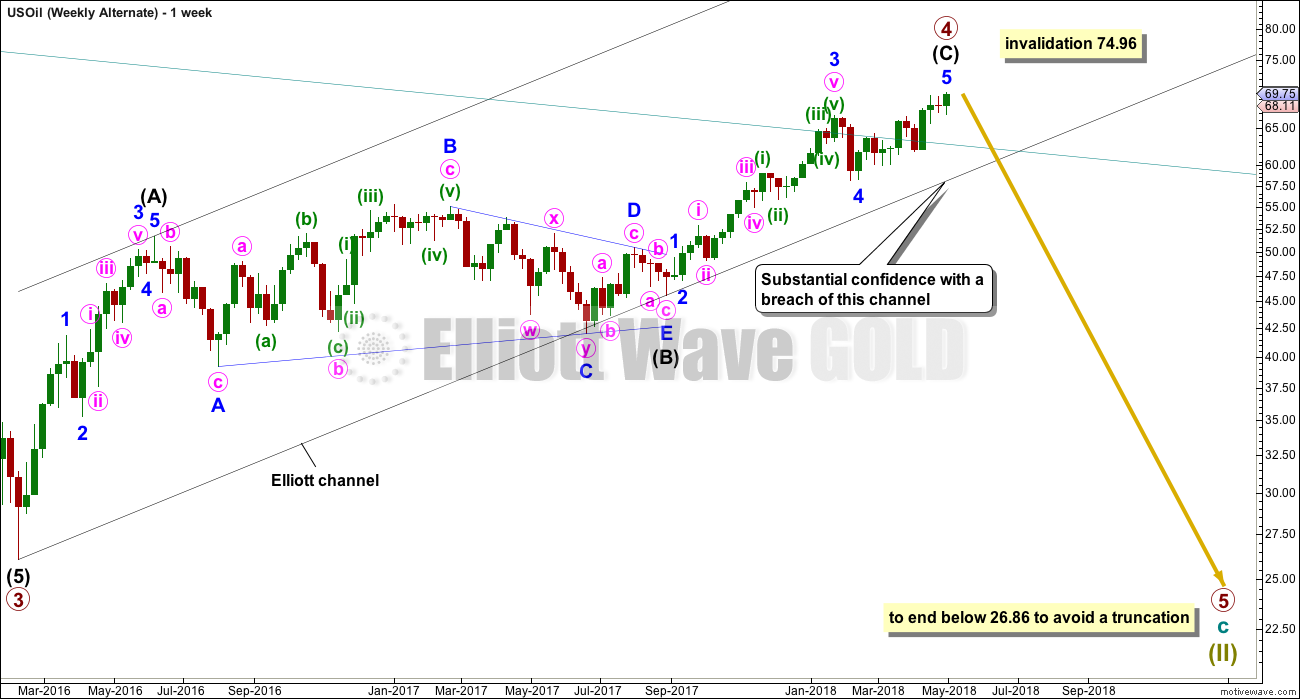A new high on Friday for US Oil shifts the probabilities of the three daily Elliott wave counts.
Summary: Classic technical analysis remains overly bullish. There is an upwards trend in place. Pullbacks are an opportunity to join the trend.
The preferred Elliott wave count is very bullish, now well in line with classic technical analysis. It expects a short term pullback but only to 66.02 – 65.19. Thereafter, it expects upwards movement to increase in momentum. The mid term target is now at 97.92. A longer term target is at 106.25.
Always practice good risk management as the most important aspect of trading. Always trade with stops and invest only 1-5% of equity on any one trade. Failure to manage risk is the most common mistake new traders make.
New updates to this analysis are in bold.
MAIN WAVE COUNT
MONTHLY CHART
It is possible that the bear market for Oil is over and a new bull market is in the very early stages.
A huge zigzag down to the last low may be complete and is labelled here Super Cycle wave (II).
Cycle wave b must be seen as complete in August 2013 for this wave count to work. It cannot be seen as complete at the prior major swing high in May 2011.
Cycle wave b is seen as a zigzag, and within it primary wave B is seen as a running contracting triangle. These are fairly common structures, although nine wave triangles are uncommon. All subdivisions fit.
Primary wave C moves beyond the end of primary wave A, so it avoids a truncation. But it does not have to move above the price territory of primary wave B to avoid a truncation, which is an important distinction.
If cycle wave b begins there, then cycle wave c may be seen as a complete five wave impulse.
Super Cycle wave (III) must move beyond the end of Super Cycle wave (I). It must move far enough above that point to allow room for a subsequent Super Cycle wave (IV) to unfold and remain above Super Cycle wave (I) price territory.
Cycle wave I may be incomplete. It may be ready to move through the middle and end of its third wave at primary degree, which may be the strongest upwards portion of cycle wave I; a strong increase in momentum and range may be ahead.
When cycle wave I is complete, then cycle wave II may be a deep correction that may not move beyond the start of cycle wave I below 26.06.
Data from FXCM for USOil does not go back to the beginning of Super Cycle wave (I). Without an accurate known length of Super Cycle wave (I) a target cannot be calculated for Super Cycle wave (III) to end using Fibonacci ratios. The target for Super Cycle wave (III) may be calculated when cycle waves I, II, III and IV within it are complete. That cannot be done for many years.
WEEKLY CHART
If a new bull market is in the very early stages for Oil, then it may have begun with two overlapping first and second waves at primary then at intermediate degree.
Primary wave 3 may only subdivide as an impulse, and within it intermediate wave (3) may be complete.
This wave count is now adjusted at the weekly chart level. It was the second daily chart in last analysis, and now it is the main wave count because technical analysis supports it.
Within intermediate wave (3), only minor waves 1 and 2 may be complete. Minor wave 3 may have just begun. The most common Fibonacci ratio is used to calculate a target for it to end. Minor wave 3 may only subdivide as an impulse, and within it minute wave ii may not move beyond the start of minute wave i below 58.13.
A new target is calculated for primary wave 3 to end, which fits with the earlier target for minor wave 3 to end.
Commodities typically exhibit swift and strong fifth waves within their impulses, and this tendency is particularly common for third wave impulses. Intermediate wave (5) may be a swift strong upwards wave when it arrives.
DAILY CHART
Minor wave 3 may have begun with a leading expanding diagonal for minute wave i.
Minute wave ii may be unfolding as an expanded flat correction, and within it minuette wave (a) subdivides as a three. Minuette wave (b) also subdivides as a three and is a 1.16 length of minuette wave (a). The most common Fibonacci ratio is used to calculate a target for minuette wave (c) to end, which is very close to the 0.382 Fibonacci ratio of minute wave i, giving a small target zone calculated at two degrees.
Second wave corrections following leading diagonals in first wave positions are commonly very deep; they may be deeper than the 0.618 Fibonacci ratio of the first wave diagonal. If the calculated target for minute wave ii to end is wrong, it may not be low enough.
There is some weakness today at the high labelled minuette wave (b). Volume did not support the last upwards day, and there is now strong double bearish divergence between price and Stochastics. This is exactly the type of weakness that should be exhibited by a B wave. This wave count today now has support from classic technical analysis.
Minute wave ii may not move beyond the start of minute wave i below 58.13.
When minute wave ii is complete, then this wave count would expect a third wave up to unfold at four degrees. The expectation would be for explosive upwards movement.
DAILY CHART II
It is also possible that minute wave ii may already be over as a relatively brief and shallow regular flat correction.
It would be unusual for a second wave correction following a first wave leading diagonal to be this shallow. The probability of this wave count must be judged to be lower than the first daily chart.
This wave count would now expect explosive upwards movement.
Within minute wave iii, no second wave correction may move beyond its start below 66.86.
ALTERNATE WAVE COUNT
MONTHLY CHART
Within the bear market, cycle wave b is seen as ending in May 2011. Thereafter, a five wave structure downwards for cycle wave c begins.
Primary wave 1 is a short impulse lasting five months. Primary wave 2 is a very deep 0.94 zigzag lasting 22 months. Primary wave 3 is a complete impulse with no Fibonacci ratio to primary wave 1. It lasted 30 months.
There is alternation in depth with primary wave 2 very deep and primary wave 4 relatively shallow. There is inadequate alternation in structure, both are zigzags. So far primary wave 4 has lasted 26 months. At this stage, there isstill reasonable proportion between primary waves 2 and 4.
Primary wave 4 may not move into primary wave 1 price territory above 74.96.
The wider Elliott channel (teal) about this whole movement may offer support to primary wave 5.
WEEKLY CHART
This wave count now expects a huge trend change for a new wave down for primary wave 5, which may last about a year or so. Primary wave 5 would be likely to make at least a slight new low below 26.86 to move below the end of primary wave 3 and avoid a truncation.
An Elliott channel is added to this possible zigzag for primary wave 4. A breach of the lower edge of this channel would provide a very strong indication that primary wave 4 should be over and primary wave 5 should be underway. Look out for some support on the way down, perhaps a short term bounce about the lower edge of the channel.
At this stage, the structure of minor wave 5 is problematic. I have not been able to see a solution at the daily chart level which sees it as either a complete or almost complete motive wave. I am unwilling to publish an Elliott wave count for the daily chart that does not have the right look. At this stage, my conclusion is that upwards movement labelled minor wave 5 is not a terminal motive structure, which would mean this wave count would be wrong.
This problem may be resolved with further price movement; if it is, I shall publish a chart in comments during the week.
TECHNICAL ANALYSIS
MONTHLY CHART
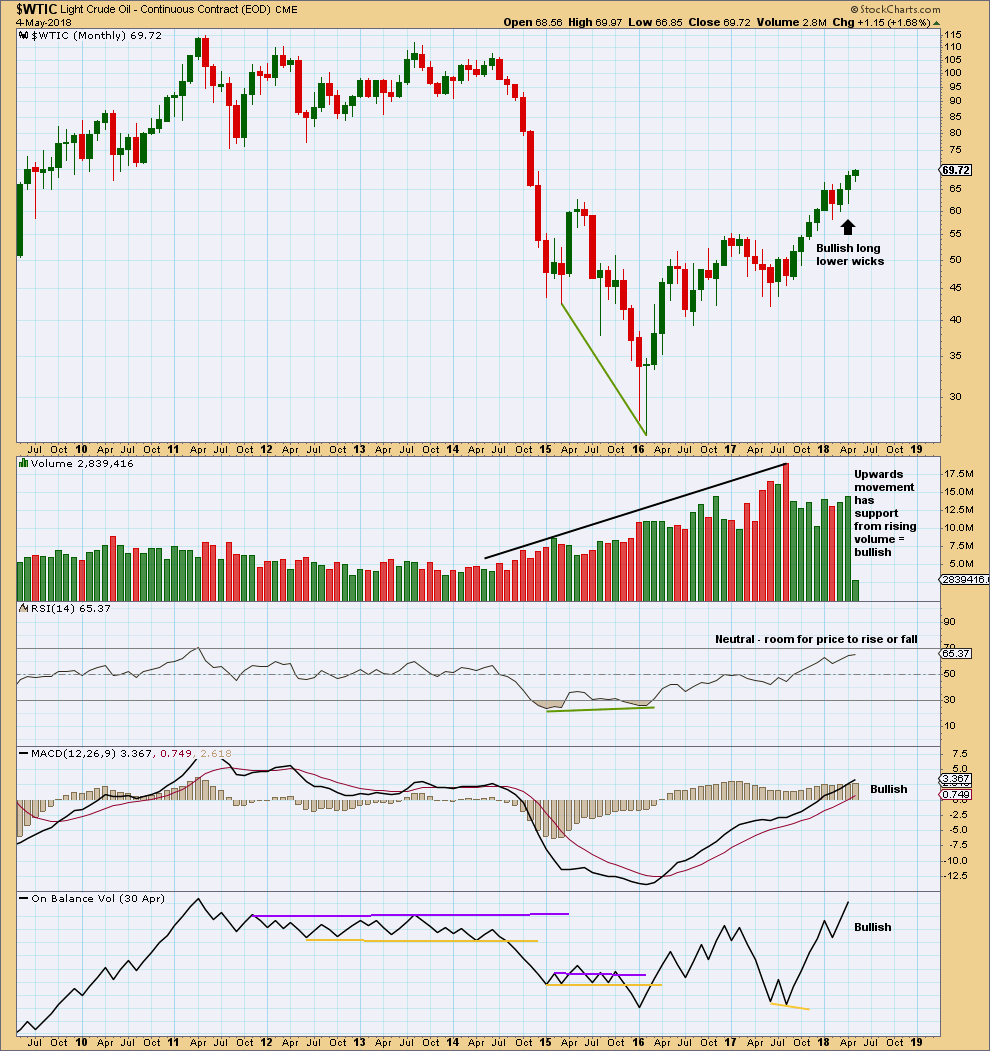
Click chart to enlarge. Chart courtesy of StockCharts.com.
For the last four months all now complete, the volume profile is bullish. There are now three completed monthly candlesticks with long lower wicks.
This chart is overwhelmingly bullish. It supports the main Elliott wave count.
Strong volume for the month of June 2017 may have been a selling climax. This is typical behaviour of commodities.
The strongest recent volume is a downwards month for August 2017. This is the only bearish indication on this chart.
DAILY CHART
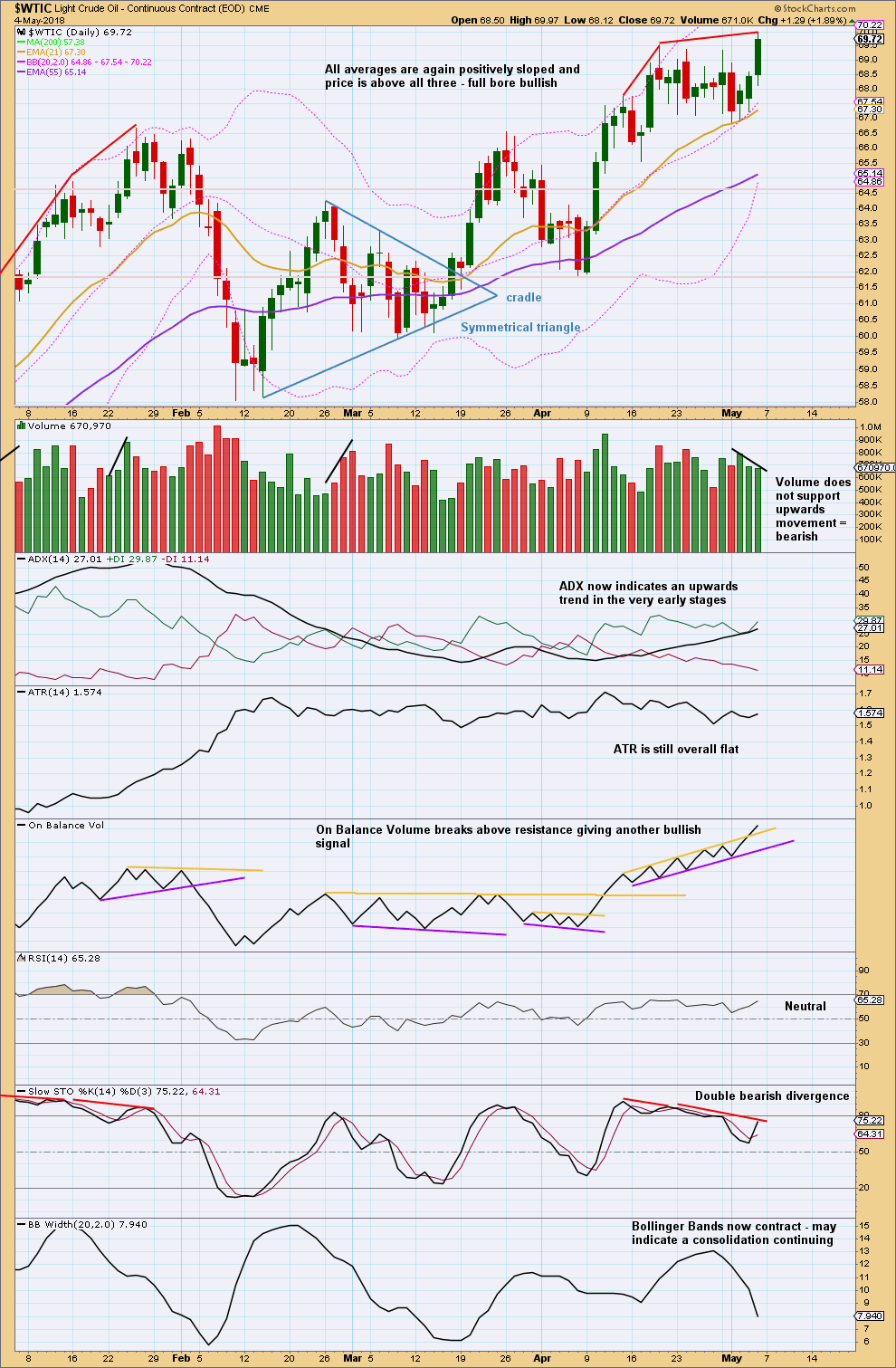
Click chart to enlarge. Chart courtesy of StockCharts.com.
It looks like a pullback may now occur for the very short term. Declining volume for the last two sessions and strong double bearish divergence between price and Stochastics support this view.
It looks like Oil is in a new upwards trend for the mid to long term. ADX and very bullish On Balance Volume support this view.
Published @ 07:04 p.m. EST.



